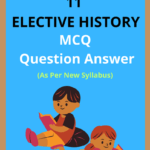Class 11 History MCQ Chapter 4 Changing Traditions Solutions to each chapter is provided in the list so that you can easily browse through different chapters Class 11 History MCQ Chapter 4 Changing Traditions Solutions and select need one. Class 11 History MCQ Chapter 4 Changing Traditions Question Answers Download PDF. AHSEC Elective History Multiple Choice Class 11 Solutions.
Class 11 History MCQ Chapter 4 Changing Traditions
Also, you can read the NCERT book online in these sections Solutions by Expert Teachers as per Central Board of Secondary Education (CBSE) Book guidelines. AHSEC Class 11 Elective History Objective Type Solutions are part of All Subject Solutions. Here we have given AHSEC Class 11 Elective History Multiple Choice Question and Answer, AHSEC Board Class 11 History Objective Type Solutions for All Chapters, You can practice these here.
Changing Traditions
Chapter: 4
| MCQ |
1. Which factor is most commonly associated with changing traditions in a society?
(a) Globalization.
(b) Isolation.
(c) Tradition preservation.
(d) Cultural stagnation.
Ans: (a) Globalization.
2. Petrarch was given the title of ‘Poet Laureate’ in Rome in
(a) 1341
(b) 1342
(c) 1343
(d) 1344
Ans: (a) 1341
3. The painting ‘Mona Lisa’ was made by
(a) Leonardo da Vinci.
(b) Michelangelo.
(c) Raphael.
(d) Donatello.
Ans: (a) Leonardo da Vinci.
4. The author of the book ‘The Prince’ is
(a) Lorenzo Valla.
(b) Gutenberg.
(c) Machiavelli.
(d) Alberti.
Ans: (c) Machiavelli.
5. The earliest universities in the European continent were set up in the country of
(a) France.
(b) Germany.
(c) Italy.
(d) England.
Ans: (c) Italy.
6. The families that gave more importance to women during the 15th century were those of
(a) aristocrats.
(b) artists.
(c) merchants.
(d) scholars.
Ans: (c) merchants.
7. Anatomy, geometry, physics, as well as a strong sense of what was beautiful, gave a new quality to Italian art, which was to be called.
(a) Aesthetic realism.
(b) Epistemological realism.
(c) Philosophical realism.
(d) Realism.
Ans: (d) Realism.
8. The Gregorian calendar was introduced by the Pope.
(a) Evaristus.
(b) Gregory XIII.
(c) Peter St.
(d) Pius I.
Ans: (b) Gregory XIII.
9. The opening of trade between Europe and China started in the.
(a) 9th century.
(b) 10th century.
(c) 11th century.
(d) 12th century.
Ans: (d) 12th century.
10. By the early fifteenth century, ______ was used for those masters who taught grammar, poetry, rhetoric, history and moral philosophy.
(a) Literates.
(b) Humanists.
(c) Authors
(d) Writers.
Ans: (b) Humanists.
11. When Renaissance occurred in Europe?
(a) 11th century.
(b) 13th century.
(c) 15th century.
(d) 16th century.
Ans: (c) 15th century.
12. What change is often observed in communities due to urbanization?
(a) Increase in communal gatherings.
(b) Decline in traditional practices.
(c) Strengthening of local identities.
(d) Rise of rural communities.
Ans: (b) Decline in traditional practices.
13. Ptolemy’s Almagest was a work on ______.
(a) Mathematics.
(b) Astronomy.
(c) Philosophy.
(d) Sociology.
Ans: (b) Astronomy.
14. Ibn Rushd was an Arab philosopher of _____.
(a) France.
(b) Germany.
(c) Britain.
(d) Spain.
Ans: (d) Spain.
15. The painting ‘Mona Lisa’ was made by.
(a) Leonardo da Vinci.
(b) Michelangelo.
(c) Raphael.
(d) Donatello.
Ans: (a) Leonardo da Vinci.

Hi! my Name is Parimal Roy. I have completed my Bachelor’s degree in Philosophy (B.A.) from Silapathar General College. Currently, I am working as an HR Manager at Dev Library. It is a website that provides study materials for students from Class 3 to 12, including SCERT and NCERT notes. It also offers resources for BA, B.Com, B.Sc, and Computer Science, along with postgraduate notes. Besides study materials, the website has novels, eBooks, health and finance articles, biographies, quotes, and more.




